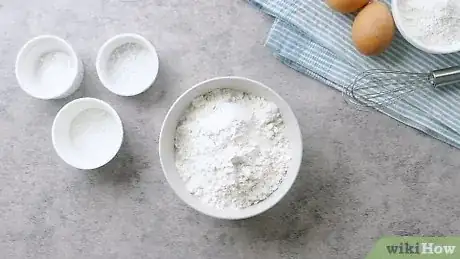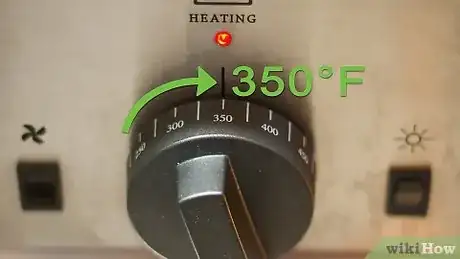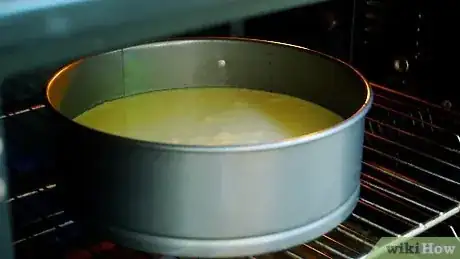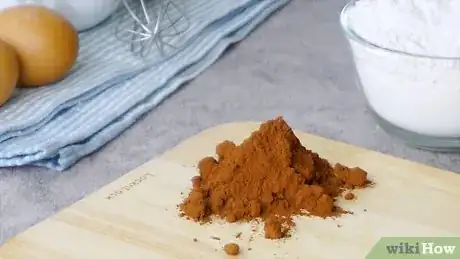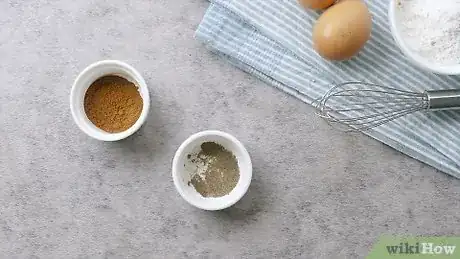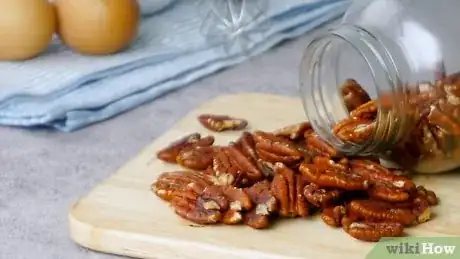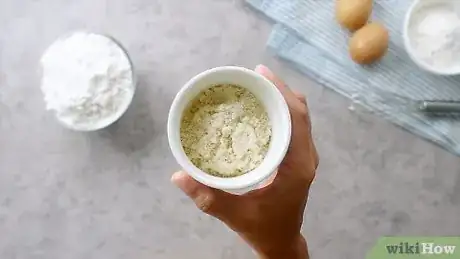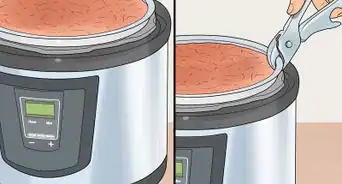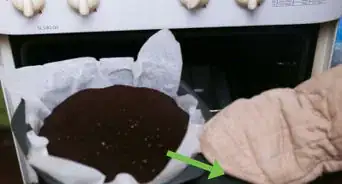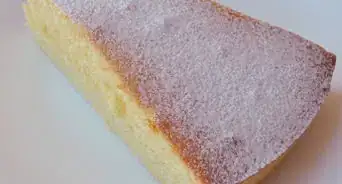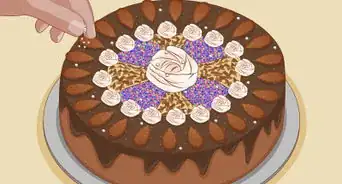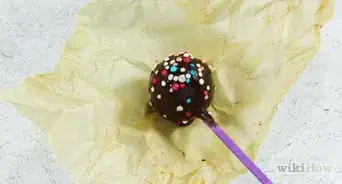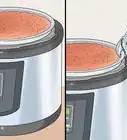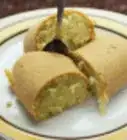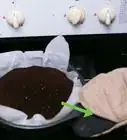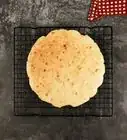This article was co-authored by Quynh La and by wikiHow staff writer, Jessica Gibson. Quynh La is a Professional Baker and the Owner of Sugar Bakery & Cafe in Seattle, Washington. With over seven years of experience, she specializes in baking cakes, cookies, croissants, and bread. Quynh holds an AAS in Culinary Arts from South Seattle College and a second AAS in Specialty Desserts & Bread from Seattle Central College.
There are 7 references cited in this article, which can be found at the bottom of the page.
wikiHow marks an article as reader-approved once it receives enough positive feedback. This article received 20 testimonials and 83% of readers who voted found it helpful, earning it our reader-approved status.
This article has been viewed 542,484 times.
If you've never made a cake before or want a treat that's not too fancy, try baking a plain cake. You don't need much besides flour, sugar, eggs, and butter to make a simple cake that's great on its own or topped with your favorite icing. Then, once you're comfortable with baking, you can make substitutions or add flavors.
Ingredients
- 1 3/4 cups (218 g) of all-purpose flour
- 1 teaspoon (4 g) of baking powder
- 1/2 teaspoon (3 g) of baking soda
- 1/2 teaspoon (2.5 g) of salt
- 3/4 cup (170 g) of unsalted butter, at room temperature
- 1 1/2 cups (300 g) of granulated sugar
- 2 large eggs, at room temperature
- 3⁄4 cup (180 ml) of buttermilk or whole milk
Makes a single 9 in (23 cm) cake
Steps
Mixing the Batter
-
1Whisk the flour, baking powder, and salt in a bowl. Put 1 3/4 cups (218 g) of all-purpose flour into a mixing bowl and add 1 teaspoon (4 g) of baking powder along with 1/2 teaspoon (3 g) of baking soda and salt. Whisk for about 10 seconds so the dry ingredients combine.[1]
The baking soda and baking powder are important for helping the cake rise as it bakes. If you haven't baked in a while, check the expiration date on your baking powder and soda to ensure they're still good.
-
2Cream the butter and sugar in a separate bowl for 4 to 5 minutes. Get out a large mixing bowl and put 3/4 cup (170 g) of room-temperature butter into it along with 1 1/2 cups (300 g) of granulated sugar. Turn on a stand or hand mixer to medium speed and beat the mixture until it becomes light and fluffy.[2]
- It's important to use room-temperature butter, which will combine smoothly with the sugar. This will make your cake light and fluffy instead of dense.
- Stop the mixer and scrape down the sides of the bowl a few times to incorporate all of the butter.
- Don't worry about over-mixing—it's really hard to do when you're creaming your ingredients together.
Tip: To cut back on the sugar, reduce the amount to 1 1/4 cups (250 g) of sugar. Keep in mind that the sugar will help the cake brown, so your reduced-sugar cake may be pale.
Advertisement -
3Beat 2 eggs into the butter-sugar mixture at low speed, 1 egg at a time. Turn the mixer down to low and add 1 room-temperature egg. Keep mixing until the egg is incorporated and then add the other egg. Continue to beat the mixture until you don't see any egg yolk or white.[3]
- Beating in room-temperature eggs will trap air in the batter so your plain cake rises in the oven.
-
4Stir in the dry ingredients and buttermilk to make a smooth batter. Keep the mixer on low speed and stir in about 1/3 of the dry ingredients. Then, get out 3⁄4 cup (180 ml) of buttermilk or whole milk and pour 1/2 of it into the bowl. Once the liquid is incorporated, add another 1/3 of the dry ingredients. Finish making the batter by stirring in the remaining buttermilk followed by the rest of the dry ingredients.[4]
- Stop stirring as soon as the last of the dry ingredients are mixed in. If you mix the batter too much, your cake can turn out tough or dense.
Baking the Cake
-
1Preheat the oven to 350 °F (177 °C) and line a 9 in (23 cm) pan. Spray a 9 in × 9 in (23 cm × 23 cm) square pan, a 9 by 5 inches (23 cm × 13 cm) loaf pan, or a 9 in (23 cm) round pan with baking spray and then cut a piece of parchment paper to fit the bottom of the pan.[5]
- Try to use a metal cake pan since this conducts heat better than glass or ceramic.
- If you'd like to make plain cupcakes, put muffin liners into 16 to 18 cavities of a muffin tin.
Tip: Parchment paper will make it easy to remove the cake from the pan and it will prevent the crust from becoming too dark as the cake bakes.
-
2Spread the batter in the pan. Scoop all of the plain cake batter into the prepared cake pan and use the back of a knife or offset spatula to spread the batter so it's level. This will prevent the cake from doming as it bakes.[6]
- If you're baking plain cupcakes instead of a cake, try dividing the batter using a cookie scoop.
-
3Bake the plain cake for 45 to 60 minutes. Put the cake on the center rack of your preheated oven and bake it for 45 minutes. The cake should become a rich golden color and start to pull away from the edges once it's baked. Since everyone's oven is a little different, it may take your oven more time to bake the cake, so don't worry if it needs up to 15 more minutes.[7]
- Avoid opening the oven door while the cake is in the middle of baking. Wait to open the door and test the cake for doneness until it's at or near the end of the baking time.
- You can also insert a toothpick or skewer into the center of the cake to see if it's done. The tester should come out clean and if it doesn't, bake the cake for a few more minutes before you check it again.
- If you're making plain cupcakes, check them after 20 minutes.
Tip: If you're baking at high altitude, consider adding an extra egg to prevent the cake from drying out. You might also reduce the baking time by 5 to 8 minutes since your cake will bake faster.
-
4Remove the cake and cool it on a wire rack for 1 hour. Turn off the oven and wear oven mitts to take the cake out. Set the pan on a wire rack and leave the cake to cool completely before you take it out of the pan.[8]
- You don't need to worry about the cake sticking to the pan since the parchment is on the bottom.
-
5Flip the cake out of the pan. Once the cake is completely cool, run a butter knife between the cake and the side of the pan. Set the pan on the counter and put an upside-down wire rack on top of the cake. Then, hold the wire rack and bottom of the pan so you can quickly flip the cake over onto the rack.[9]
- You won't need to wear oven mitts since the cake is cold at this point.
- You can also use a paring knife to loosen the cake and get it out of the pan.
-
6Peel off the parchment and serve the plain cake. Slowly peel away the parchment paper liner and throw it away. Flip the cake over and slice it into pieces for serving. If you'd like to decorate the cake a little, consider dusting it with powdered sugar, frosting it with buttercream, or pouring a simple glaze over it.[10]
- Put leftover cake into an airtight container and keep it at room temperature for up to 2 days. While you can refrigerate the cake for up to 7 days, this can make it dry out.
Trying Variations
-
1Substitute some of the flour with cocoa to make a chocolate cake. To turn your plain cake into a rich, chocolate cake, swap 1/2 cup (65 g) of cocoa powder for 1/2 cup (65 g) of the all-purpose flour. You can also add 1 cup (175 g) of bittersweet chocolate chips to make a double-chocolate cake.[11]
- Consider frosting your chocolate cake with cream cheese frosting or chocolate buttercream.
Red velvet cake variation: Add just 1 tablespoon of cocoa powder to the dry ingredients and add 1⁄2 tablespoon (7.4 ml) of white vinegar along with 1 fluid ounce (30 ml) of red food coloring to the wet ingredients.
-
2Stir in 1 to 2 teaspoons (4.9 to 9.9 ml) of an extract to add flavor. Adjust the flavor of your plain cake by stirring in a little flavoring extract when you add the eggs to the batter. Consider using vanilla, lemon, almond, coffee, coconut, or orange blossom extract to your batter.[12]
- If you're making a citrus-flavored cake, try rubbing the zest from 1 lemon, 1 orange, or 1/2 of a grapefruit into the sugar for the cake before you cream it with the butter. This will release citrus oils into the sugar.
-
3Add spices to the dry ingredients for a warm spice cake. Whisk 1 teaspoon (2 g) of ground cinnamon, 1/2 teaspoon (1 g) of ground cardamom or allspice, and a pinch of ground black pepper to the dry ingredients of your plain cake. Once you've made the spiced batter and baked the cake, you might want to frost it with cream cheese buttercream.[13]
- For extra spice, stir 1 tablespoon (7 g) of grated ginger into butter and sugar mixture.
-
4Scatter toppings over the plain cake before you bake it. To give your cake a little extra color or crunch, add a handful of chopped or slivered nuts, such as almonds or pecans. You could also scatter colorful sprinkles for a festive birthday cake or a crumbly streusel to make a simple coffee cake.[14]
- For the crunchiest texture, use toasted nuts instead of raw nuts.
-
5Use an egg substitute if you'd like to make an eggless cake. If you don't want to bake with eggs, use a vegan egg substitute or 3 fluid ounces (89 ml) of milk, buttermilk, or sour cream instead of the 2 eggs. Keep in mind that your plain cake will be a little dryer than a cake made with the eggs.
- To make a completely vegan plain cake, you'll also need to use a vegan butter product and substitute alternative milk, such as almond or oat milk, for the buttermilk.
-
6Make a gluten-free cake by adjusting the flour. Purchase a gluten-free baking flour that's designed to use in place of all-purpose flour. You should be able to use substitute the same amount of gluten-free baking flour as the all-purpose flour called for in the recipe, so it's easy to use!
- If you'd like to substitute gluten-free flour, such as almond or chickpea flour, follow the manufacturer's instructions for baking with it. Keep in mind that the texture of your cake may be more crumbly than if you bake with all-purpose flour.
Community Q&A
-
QuestionHow long does it take to make a plain cake?
 Community AnswerAbout 15 minutes to make the dough and 25 to 30 minutes to cook for an oven preheated at 160 degrees Celsius (320 Fahrenheit).
Community AnswerAbout 15 minutes to make the dough and 25 to 30 minutes to cook for an oven preheated at 160 degrees Celsius (320 Fahrenheit). -
QuestionWhat is vanilla essence?
 Jerry CatCommunity AnswerVanilla essence is also called vanilla extract. It is food-safe alcohol that has had vanilla beans soaking in it. It is generally not diluted, so you only need a tiny bit. The alcohol will burn off in the oven, so it is safe for children.
Jerry CatCommunity AnswerVanilla essence is also called vanilla extract. It is food-safe alcohol that has had vanilla beans soaking in it. It is generally not diluted, so you only need a tiny bit. The alcohol will burn off in the oven, so it is safe for children. -
QuestionCan I make this cake in a microwave oven?
 Community AnswerYou cannot make cakes in the microwave oven unless you have a special recipe designed for that purpose. Otherwise, the cake will not be baked properly. There will be hot spots and other places where the cake is raw, or it may even explode in the microwave, creating a terrible mess.
Community AnswerYou cannot make cakes in the microwave oven unless you have a special recipe designed for that purpose. Otherwise, the cake will not be baked properly. There will be hot spots and other places where the cake is raw, or it may even explode in the microwave, creating a terrible mess.
Things You'll Need
- Measuring cups and spoons
- Whisk
- Mixing bowls
- Spatula
- Mixer
- Baking spray
- Wire rack
- 9 in (23 cm) cake pan
- Parchment paper
References
- ↑ https://www.joyofbaking.com/bakingsoda.html
- ↑ https://food52.com/recipes/75081-the-ultimate-customizable-everyday-cake
- ↑ https://www.seriouseats.com/2017/05/how-to-make-a-cake.html
- ↑ https://food52.com/recipes/75081-the-ultimate-customizable-everyday-cake
- ↑ http://dish.allrecipes.com/cake-pan-size-conversions/
- ↑ https://www.seriouseats.com/2017/05/how-to-make-a-cake.html
- ↑ https://food52.com/recipes/75081-the-ultimate-customizable-everyday-cake
- ↑ https://www.seriouseats.com/2017/05/how-to-make-a-cake.html
- ↑ https://www.seriouseats.com/2017/05/how-to-make-a-cake.html
- ↑ https://www.stilltasty.com/fooditems/index/18598
- ↑ https://www.tasteofhome.com/recipes/grandma-s-red-velvet-cake/
- ↑ https://food52.com/blog/21428-one-perfect-cake-unlimited-ways-to-customize-it
- ↑ https://food52.com/blog/21428-one-perfect-cake-unlimited-ways-to-customize-it
- ↑ https://food52.com/blog/21428-one-perfect-cake-unlimited-ways-to-customize-it
About This Article
To make a plain and simple cake, start by whisking flour, baking powder, and salt in a large bowl. In a separate bowl, beat together butter, sugar, and eggs. Once everything is blended, stir the dry ingredients into the wet ingredients to make the batter, and pour the batter into a pan lined with parchment paper. Pop the pan in the oven at 350 degrees Fahrenheit, and bake the cake for 45-60 minutes. You'll know it's done when it turns a rich, golden color and starts to pull away from the edges. To learn how to spice up a plain cake with delicious added flavors, scroll down!
